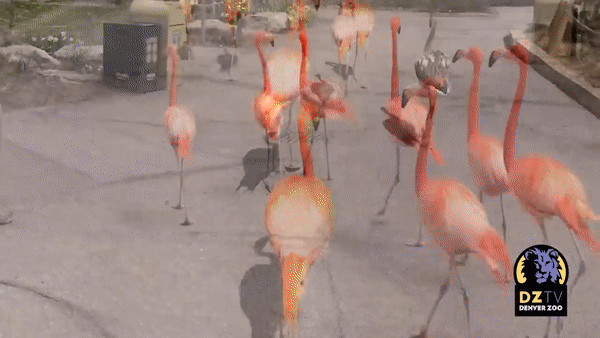Flamingos, with their iconic pink plumage and stilt-like legs, are truly remarkable birds. These wading birds are known for their striking appearance, with heights ranging from 3 to 5 feet and impressive wingspans reaching around 5 feet. Observing these creatures, one might wonder: with those wings, are flamingos actually capable of flight? Let’s delve into the fascinating world of flamingos to uncover the answer to the question, Can Flamingos Fly? and explore more about their unique characteristics.
Yes, flamingos can fly, and they are in fact quite adept fliers, often undertaking flight for various reasons. Despite their seemingly ungainly proportions on land, flamingos are capable of achieving flight speeds of approximately 35 miles per hour over shorter distances. When embarking on longer journeys, these pink birds can even reach speeds of up to 40 miles per hour, showcasing their impressive aerial abilities. Furthermore, flamingos have been recorded flying at remarkable altitudes, reaching up to 20,000 feet in some instances, demonstrating their capacity for high-altitude flight.
 Flamingos explore the Denver Zoo, highlighting their presence in captivity where flight is often restricted.
Flamingos explore the Denver Zoo, highlighting their presence in captivity where flight is often restricted.
Why Flamingos in Zoos Don’t Typically Fly
If flamingos are indeed capable of flight, why do they often appear earthbound, particularly in zoo environments? The reason behind this observation is that flamingos in zoos frequently have their flight feathers trimmed. This practice is implemented to prevent the birds from escaping their enclosures, ensuring they remain safely within the zoo premises. However, it’s important to note that the trimming of flamingo flight feathers is a contentious issue, widely regarded by many as an inhumane practice. Organizations like the American Bird Conservancy advocate against feather trimming, emphasizing the importance of allowing birds to express their natural behaviors, including flight.
The Curious Case of Flamingo Sleep: Standing on One Leg
Beyond their flight capabilities, flamingos exhibit other intriguing behaviors, such as their unique sleeping posture. Flamingos are often observed sleeping while standing on just one leg, with their heads tucked back and resting upon their backs. This seemingly precarious stance is actually quite normal and comfortable for these birds. Balance is inherent to flamingos; they perform a multitude of activities while standing on a single leg. Scientific research, including a 2017 study, has revealed that flamingos possess a “locked” resting position in their joints, enabling them to stand on one leg for extended periods without engaging any muscular effort.
The Pink Flamingo Mystery: Diet and Coloration
Perhaps one of the most captivating aspects of flamingos is their vibrant pink color. Interestingly, flamingos are not born pink. In fact, newly hatched flamingos have white feathers. Their characteristic pink hue develops over time and is directly linked to their diet. Flamingos primarily feed on brine shrimp and algae, both of which are rich in carotenoids. Carotenoids are natural pigments found in various plants and algae, responsible for red, yellow, and orange colors in foods like tomatoes and carrots. Brine shrimp consume algae containing carotenoids, and when flamingos ingest these shrimp and algae, they metabolize the pigments. It is these metabolized carotenoids that are deposited in their feathers, resulting in the flamingo’s signature pink coloration.
In conclusion, flamingos are indeed capable fliers, able to reach impressive speeds and altitudes. The reason they may not fly in zoos is often due to feather trimming, a practice considered inhumane by many. Furthermore, flamingos possess fascinating traits such as sleeping on one leg and acquiring their pink color from a carotenoid-rich diet. These magnificent birds are a testament to the wonders of nature, showcasing a unique blend of aerial prowess, peculiar habits, and striking beauty.
